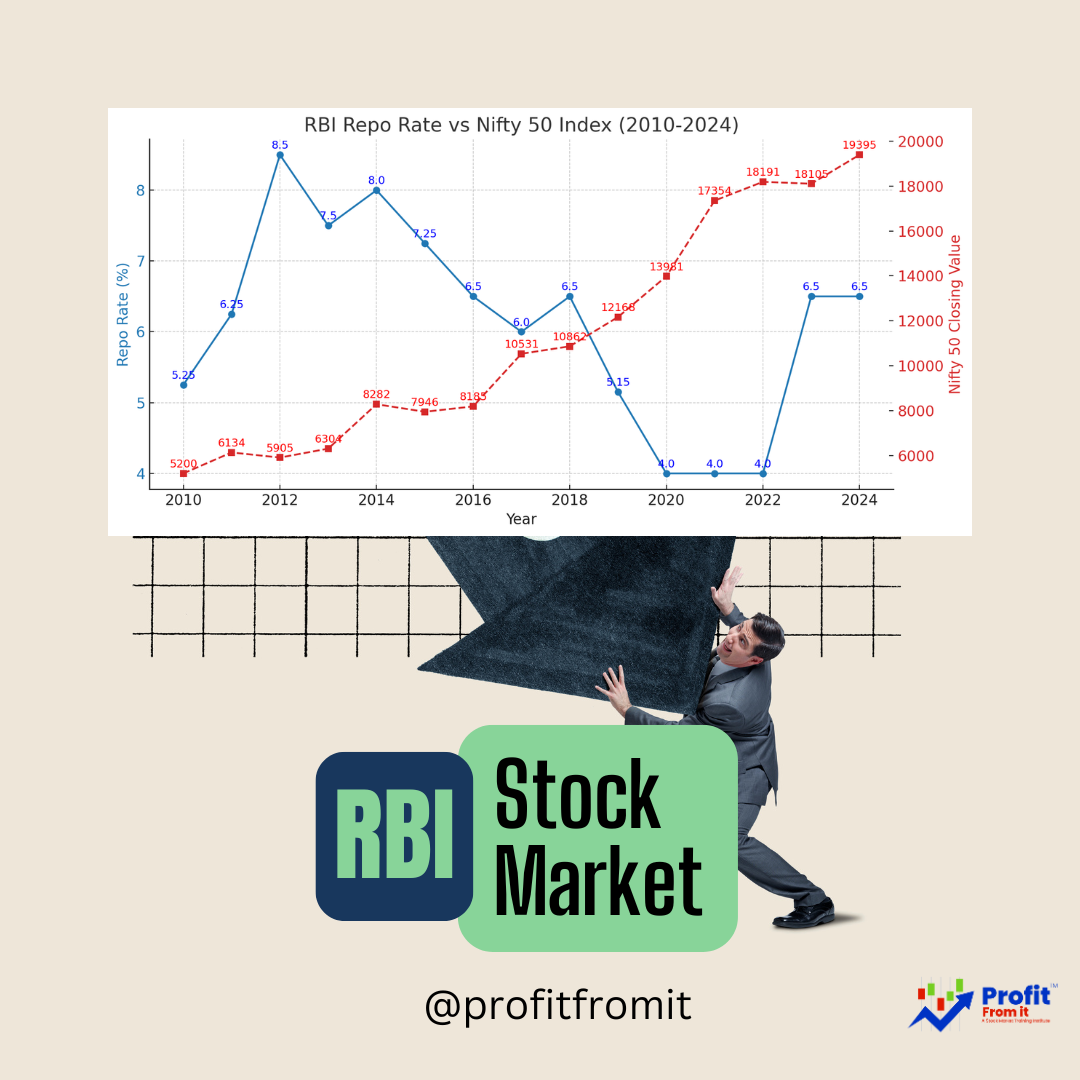
📊 RBI Repo Rate Trends & Nifty 50: A 15-Year Market Impact Analysis
The Repo Rate is one of the most powerful tools used by the Reserve Bank of India (RBI) 🏦 to control inflation, liquidity, and economic growth. It directly affects borrowing and lending rates across the economy, influencing businesses, individuals, and the stock market 📈.
🔄 1. How Repo Rate Affects the Economy and Markets
🔺 A) When the RBI Increases the Repo Rate 📈
🏦 Cost of Borrowing Increases – Banks borrow at a higher rate, making loans expensive for businesses and individuals.
💰 Reduced Liquidity – Higher rates discourage borrowing, reducing excess money in the economy.
📉 Impact on Inflation – As spending and investment slow down, inflation comes under control.
📉 Stock Market Impact:
🚗 Auto Sector, Real Estate, and Banking suffer as borrowing costs rise.
📊 Overall Market Decline – Business profits shrink due to higher interest payments.
🔻 B) When the RBI Decreases the Repo Rate 📉
✅ Cheaper Borrowing – Loans become more affordable for businesses and individuals.
💸 Higher Liquidity – More money flows into the economy, boosting spending & investments.
🔥 Boost to Growth, but Inflation Risk Increases – Lower rates increase consumption, but can also cause inflation.
🚀 Stock Market Impact:
🏠 Real Estate, Banking, and Auto Sector boom due to lower borrowing costs.
📈 Economic Growth Stocks rally, as lower rates make expansion easier.
📌 2. Sectors Most Affected by Repo Rate Changes
🔥 A) Interest Rate-Sensitive Sectors (Direct Impact)
1️⃣ 🏦 Banking & Financial Services 📉📈
Higher Rates → 📊 NIM (Net Interest Margin) expands in the short term, but credit growth slows.
Lower Rates → 💳 Loan demand rises, but NIM may shrink if deposit rates don’t adjust quickly.
2️⃣ 🏠 Real Estate & Infrastructure 🏗️
Higher Rates → 📉 Expensive home loans → Lower demand for property.
Lower Rates → 🔥 Affordable housing → Higher property demand.
3️⃣ 🚗 Automobile Sector
Higher Rates → ❌ Auto loans become expensive → Sales decline.
Lower Rates → ✅ Car & two-wheeler demand surges as loan EMIs decrease.
📈 B) Capital-Intensive & Growth Sectors (Indirect Impact)
4️⃣ 🛍️ Consumer Durables & Retail
Lower Rates → 💸 More discretionary spending (people buy expensive products on credit).
Higher Rates → 📉 Demand slowdown as borrowing becomes expensive.
5️⃣ ⚡ Infrastructure & Power
Higher Rates → 🚧 Costlier debt-financed projects → Slower expansion.
Lower Rates → ✅ Easier funding → Faster project execution.
6️⃣ 💻 Technology & IT
Less Direct Impact as IT companies depend more on global demand than on domestic interest rates.
Stock valuations benefit from lower rates, as future earnings are discounted at a lower rate.
💡 3. Long-Term Strategy When Repo Rates Start Decreasing
When the RBI begins a rate-cutting cycle, it signals economic expansion 📈, increased liquidity 💰, and a potential market rally 🚀. A smart investor can take advantage of this shift.
✅ Investment Strategies During a Rate Cut:
🔹 A) Invest in Rate-Sensitive Sectors Early
✅ 🏦 Banking stocks – Private Banks & NBFCs benefit as credit demand rises.
✅ 🏠 Real estate stocks – Property developers & housing finance companies gain from lower loan rates.
✅ 🚗 Auto stocks – Car & two-wheeler manufacturers see increasing demand.
🔹 B) Focus on Growth Stocks
📊 Lower rates reduce borrowing costs, making expansion easier for companies.
🚀 Sectors to watch: Consumer goods, retail, infrastructure, and IT.
🔹 C) Consider Bond Investments
📈 As interest rates fall, bond prices rise (since existing bonds with higher rates become more attractive).
🔥 Debt mutual funds, G-Secs, and long-duration bonds perform well.
🔹 D) Avoid Cyclical Stocks in Late Stage of Rate Cuts
⚠️ If rates drop too low for too long, it may indicate an economic slowdown or excessive inflation.
🛡️ Defensive sectors like FMCG, pharmaceuticals, and utilities might be safer options.
📊 4. Historical Context: How Nifty Reacted to Rate Changes
Looking at past repo rate cuts & hikes, we see:
📅 2010-2013:
📈 Repo rate hikes (from 5.25% to 8.50%) led to market stagnation.
📅 2014-2017:
📉 Rate cuts boosted Nifty from ~6,300 to 10,500.
📅 2020 (Post-COVID):
🛑 Ultra-low rates (4.00%) after the pandemic supercharged the market rally 🚀.
📅 2022-2023:
📈 Rate hikes (to 6.50%) slowed the market, but it remained resilient.
🎯 5. Conclusion & Key Takeaways
✅ Falling repo rates signal a pro-growth environment, favoring stocks in banking, real estate, auto, and infrastructure.
✅ Long-term investors should accumulate quality growth stocks early in the rate-cut cycle.
✅ Bond investments gain value during prolonged rate cuts.
✅ Monitor inflation & economic indicators to adjust strategies accordingly.
💡 Key Takeaway: Interest rate cycles create investment opportunities – being ahead of the curve ensures long-term gains! 🚀📈
🤔 Comment Below if You are looking at the rate cut cycle in India! 😊



 for Investors The provided chart outlines key metrics for Nifty 500 companies across different periods (FY22 t.png)




